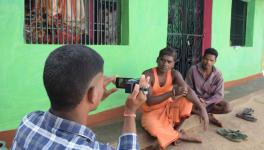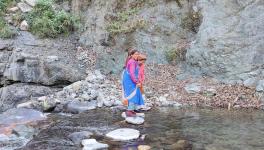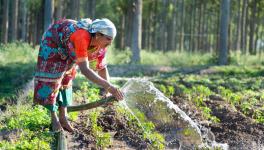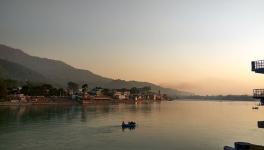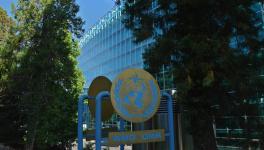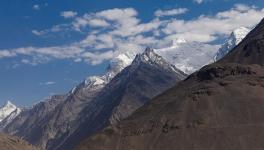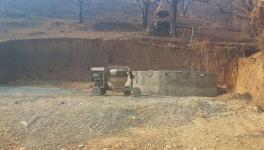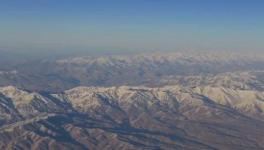Adani is Breaking Ground in Australia
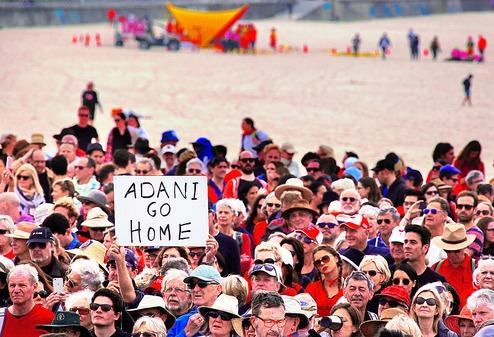
Image Courtesy: Telegraph India
With Queensland granting final environmental approval on Thursday, June 13, Adani Australia is set to begin work immediately on the most controversial coalmine in Australia. The Carmichael coalmine will proceed despite continuing and mounting evidence that the economics does not add up. Six other megamines are expected to follow, one of them being a partnership between the Indian GVK Group and the Australian Hancock Group owned by billionaire Gina Rinehart, officially the world’s richest woman.
The region, the Galilee Basin, will be the first new coal basin to be opened in Queensland in five decades, at a time when coal is in terminal decline and scientists warn that no new coal mines should be built to keep global warming within 2 degrees.
The Galilee Basin is a remote region in central Queensland, a semi-desert in the arid north of Australia, and holds a reservoir of coal as big as the United Kingdom. Being in the “business of coal”, and singularly focussed on increasing export of coal during the last mining boom that lasted between 2006 and 2014, the Queensland government had aimed to “develop” the Galilee Basin as one of the four pillars of Queensland’s economic growth. Will all those dreams now be fulfilled, and if so, at what cost? As the “first cab off the rank”, for the Galilee takes off nearly a decade after it was first proposed, it is worth re-looking at who and what are at stake.
The Galilee, that evokes visions of Jupiter’s moons in places, is a landscape unfamiliar to the Indian eye, and for most parts even the Australian eye. On the surface, it appears dry and speckled with crumbling rocks and stunted vegetation stretching across a vast expanse of red dirt. The region contains a few inland rivers, some of them flow east to the Great Barrier Reef; others drain into Australia’s inland sea, Lake Eyre. They are shallow with a highly variable flow. The Basin is sparsely populated, mostly consisting of rural towns and scattered properties of pastoralists and graziers. The closest towns to the Galilee Basin are Alpha with a population of 500 and Clermont with around 2,000; they are anticipating a boom from the “opening up” of the Galilee Basin.
The closest large economic centres lie on the coast - Townsville to the northeast and Mackay directly to the east. Mackay, which serves as a mining services town for the coal producing Bowen and Surat Basins of Queensland, flourished during the mining boom with an expanded coal-export trade through the Hay Point Terminal, south of the city. Townsville regrettably has a different story to tell; it continues to reel from the closure of a nickel refinery owned by Clive Palmer, whose proposed Alpha coalmine sits next to Adani’s Carmichael and who played kingmaker in last month’s federal elections. With high rates of unemployment, Townsville is hungry for jobs, and in ousting its incumbent labour MP in the federal elections, it awarded the Liberal Party’s consistency in supporting the Adani project.
Sacred Waters, Ancient Land
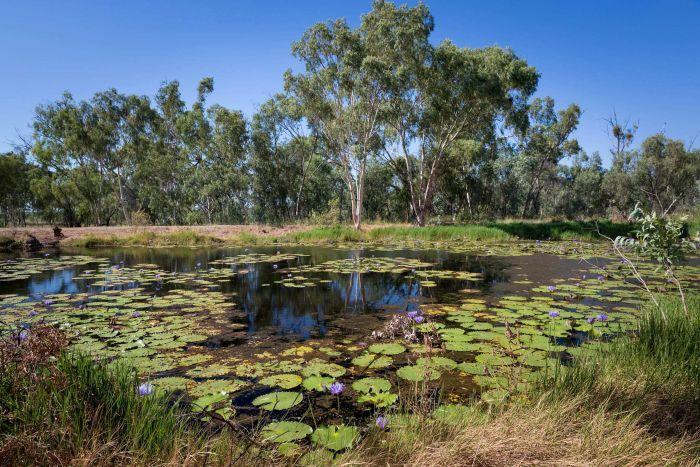
Doongmabulla Springs
The nondescript surface of the Galilee Basin carries one exceptional mark, the Doongmabulla Springs, sacred to the Wangan and Jagalingou (W&J), traditional owners of the land on which Adani’s Carmichael mine will now proceed. Its rippling, blue lotus-fringed pools function as an oasis in the semi desert.
Also read: Will Australia’s New Govt Change Fate of Adani’s Carmichael Project?
Adani’s ground water management plan, the last hurdle to be cleared by the Queensland government in its post-election swiftness, had been challenged and stalled repeatedly till political haste ensured its successful passage through the hoops of scientific approval. The challenge for this plan lay in identifying the sources of the spring oases, and determining whether they are separate and therefore, are at risk from the sources of the mine itself. Even Federal Government groundwater studies have not been able to ascertain the exact source of the springs. Without any evidence for certitude, Adani has falsely assumed the sources to be separate, risking permanently draining the springs.
The source of these desert oases, lying deep within the earth, signifies a place of dreaming and life. According to W&J folklore, the creator being, Rainbow Serpent, also known as the Mundunjudra in local aboriginal language, arose from the sources to shape the land, rivers and waterholes of Australia. Responding to the Queensland government approval yesterday, W&J spokesperson and the face of the campaign, Adrian Burragubba said, “It interferes with the practice of our culture and ceremony, our law and religion. The ecolosystem is our home. We are being told we must give this up for a few second-rate jobs in a sunset industry.”
The Wangan and Jagalingou have been fighting for legal recognition of their ancient custodianship of these lands since 2004, a good half decade before the Queensland government got serious about its plans to open greenfield (previously uncharted territory) coalmines in the region at the peak of Australia’s mining boom. Since then, they have been fighting Adani and Queensland in and out of the courts. At the United Nations, they have asserted their sovereignty and refusal to mining on their land. Adani Australia, following an “attack dog strategy”, is now attempting to bankrupt the W&J for the legal costs incurred during previous cases.
Adrian Burragubba vows to continue the fight by taking the matter to the International Court of Justice at The Hague. He concluded his statement with the affirmation that, “We are the water protectors. We want to look after the land for all future generations. We said no to Adani and we will keep saying no. Adani is not welcome in our country.” The federal court in Queensland is still hearing the W&J’s Native Title rights case.
Lifeblood of a Dry Continent
The W&J folklore of the sacred springs enfolds a complex geological phenomenon, one that makes life possible in the dry interiors of Australia. Scientists and hydrologists have still not been able to map the interconnections between the deep seated aquifers of Australia’s Great Artesian Basin, a “fossil” reservoir of water that spreads deep beneath 22% of the continent’s arid interiors, supplying freshwater to the remote parts of four states. Farmers west of the Great Diving Range rely on water from aquifers that drain into the Great Artesian Basin for sustaining trades and livelihoods, and have been doing so since the first bore-wells were sunk in the 19th century.
Since “the pits of the Galilee mines are lower than the actual aquifers” connecting to the Great Artesian Basin, apart from the risk of two and a half ‘Sydney Harbour’s’ worth of water being drained cumulatively from the mines, there is a chance that the aquifers themselves can drain out. The government added to the concerns of local farmers in the middle of Queensland’s worst drought in living memory that affected 90% of Queensland by granting Adani a 60 years licence to withdraw ‘unlimited’ amounts of groundwater in the region. The licence acknowledged that the mine would impact underground water levels in the region. The government’s move was accompanied by legislative amendments that exempt Adani from public scrutiny for water use in the Galilee Basin.
Also read: ‘No Means No’: Adani’s Land Woes in Australia
The issue had sparked joint protests from farmers and environmental groups. A new mobilisation of farmers from the interiors of Queensland close to the Galilee Basin –Farmers for Climate Action – joined with environmental groups in Queensland to protest the impacts of the Adani mine on Queensland water through a regional road show titled ‘Our lifeblood, our water’ last April. Bruce Currie, a prominent face in the newly formed group and an owner of a large cattle property “Speculation” adjacent to GVK-Hancock’s mines had travelled to Mundra as part of a ‘citizens delegation’ to deliver an open letter signed by 90 prominent Australians including cricketers Greg and Ian Chappell requesting Adani to abandon the project. The trip to India “had not changed his mind about Adani”; speaking at a rally in Brisbane two days before the final approval, he said he feared that “the project (will be) approved and they will be ignoring the science”.
‘Carbon Bombs’ and ‘Reef Killers’
The plan to develop the Galilee Basin had sent global shockwaves on account of what it meant for emissions embedded in Australia’s coal exports. Based on initial proposals, all the Galilee mines combined were estimated to add 705 millions tonnes of C02 each year, roughly four times Australia’s domestic emissions. Environmental groups from around the country who had come together in 2011 to discuss Greenpeace’s research on the scale and impact of the initial nine proposals were left “gobsmacked” with the findings.
The report Cooking the Climate Wrecking the Reef state that if fully developed, the Galilee Basin could produce 330 mtpa (million tonne per annum) of coal, which when burnt could make Galilee the seventh biggest emitter in the world; the rest of Australia would trail at fourteenth on such a list. Coal from the Adani mine alone, if developed according to the initially proposed full capacity could create an estimated average annual emission of 79 million tonnes of carbon dioxide that is greater than the average emission of either of India’s two neighbours Bangladesh or Sri Lanka.
For environmentalists, this prospect rang the loudest alarm bells when balanced against the latest Intergovernmental Panel on Climate Change (IPCC) forecasts and scenarios of global warming. Scientific estimations of the world’s available “carbon budget” showed that in order to keep global warming within the two degrees target and to have any chance of meeting the desired 1.5 target of the Paris accord, all existing coal reserves needed to be phased out and no new coalmines should be built. Specifically in Australia, “90% of known, extractable coal in existing coal reserves needed to be treated as “unburnable carbon” and left in the ground. Therefore, new coalmines could not be justified.”
National, state and local groups were doubly alarmed about what this meant for the Great Barrier Reef both directly and indirectly. Described as the “closest most people will come to Eden” by Australian writer and activist Judith Wright, the world’s largest reef system stretches 2,300 kilometres along the coastline of Queensland from the far north to the centre. Even though the Carmichael mine is situated 400 kilometres inland, the cumulative effects from the Galilee Basin would affect the Reef through increased ports and shipping traffic, and exacerbating coral bleaching from a manifold increase in carbon emissions.
Even as the Galilee proposals began travelling through various approval systems in 2012, the UN warned that the Reef was ‘in danger’ of losing its ‘Heritage Status’ unless Australia acted to protect it, especially from ‘threatening new port-developments along the coast’. The warning pre-empted an increase in coal activity if Galilee were fully developed; the same Greenpeace report estimated that 10,000 coal-laden ships a year cross would the Great Barrier Reef by 2020, a 480% increase from the 1,722 ships that entered the Reef’s World Heritage area in 2011.
Also watch: Adani Group Chasing Carmichael Coal Mine Dream
And then came successive summers of ‘record’ temperatures and ‘record’ bleaching of Reef. The summer of 2012-2013 compelled the Australian Bureau of Meteorology to add a new colour – purple – to Australia’s heat-maps in order to depict regions experiencing extreme temperatures never recorded before. In 2016 and 2017, as temperatures on land and sea soared, large parts of the Great Barrier Reef bleached white. A National Coral Bleaching Taskforce found that only 7% of corals had been completely spared in the 2016 bleaching event. Professor Terry Hughes from James Cook University near Townsville who led the taskforce said in a tweet, “I showed the results of aerial surveys of bleaching on the Great Barrier Reef to my students, and then we wept!”
Could not ‘Stop Adani’
Stacked against extreme political will, neither violation of fundamental rights of indigenous people, scientific evidence or a concerted civil society movement under the ‘Stop Adani’ banner could prevent the Galilee Basin from being opened up for exporting coal, beginning with the Adani coalmine.
It is believed that the failure of the Copenhagen talks in reaching a global consensus beyond Kyoto triggered the global climate activist network to reconsider their advocacy strategies to point their fingers directly at large oil, coal and gas, collectively called “fossil-fuel” projects. Such projects would be treated as a ‘risk to the planet’s future’. In Australia, this shift in strategy came to focus dominantly on export-coal projects. Climate activist groups began to ‘paint’ large carbon intensive projects, and Australia’s coal reliance, as major culprits. Slogans such as ‘keep coal in the ground, or variously ‘quit coal’, ‘end coal’, and ‘say no to fossil fuels’ gained currency for environmental groups and their supporters.
Another parallel track of activism around climate change targeted banks and investors of large coal, oil and gas mining projects. Known as the ‘divestment campaign’, this form of activism deflected funding away from large extractive projects by appealing to ‘image sensitive’ institutional funders, as well as by leveraging the fact that globally, the production of and investment in renewable energy was rapidly gaining ground. These various movement tracks converged under the ‘Stop Adani’ campaign, a highly visible nationwide mobilisation of forty national, state and regional environmental groups united under the common purpose of moving Australia away from coal exports.
The network registered 100 new local groups from all around the country within three months of formally coming together in 2017 after the ‘Citizens’ Delegation to India’. Its prominent Red and White Stop Adani signs on a black background were ubiquitous across the major metropolises along the east coast – Melbourne, Sydney and Brisbane. It made the flagship project of the Galilee Basin, Adani’s Carmichael, a ‘litmus test’ for Australia’s climate action.
Also watch: Adani Gets Permit for Carmichael Mining Project in Australia
The movement failed to stop construction of the Carmichael mine, but achieved some critical milestones along the way such as ensuring that all major Australian banks pull out of the project and mounting enough political pressure to ensure that Adani and the Galilee projects do not get public subsidies. The movement caused a delay of more than five years to Carmichael through a spate of litigations – excluding the challenges by the W&J, Stop Adani has mounted 10 cases against the project – and difficulties in securing investments; this was matched by globally coal becoming more unprofitable to dig out. Adani shrunk from its initial ambition of a $16.5 billion multi-investment project producing 60 mtpa of coal, the largest in the southern hemisphere, to a $2 billion self-funded mine that will begin by producing 10 mtpa of coal.
A day before Queensland granted final approval to Adani, the Australian Conservation Foundation, a national NGO that is part of Stop Adani, won in court against the Australian government. The latter conceded in court to not having taken ‘thousands of valid public submissions into account’ as to if and how the Carmichael project should be assessed, in direct violation of Australia’s Environment Act. The Stop Adani movement will protest the mine decision outside the Indian High Commission in Canberra, where veteran environmentalist and Greens leader Bob Brown is expected to raise the issue of Adani’s forest destruction for coalmining in India.
Why Bother?
The true significance of what the Doongmabulla conveys to the Wangan and Jagalingou lies underground. As does what the Galilee signifies for the Queensland government and jobseekers. And, in an opposite sense, for the diverse, decade-long civil society oppositions including that of local farmers to plans to open it up for mining.
Against moralistic claims that Adani’s coal will lift millions of poor Indians from poverty, justifications for India’s reverse colonisation of the first world, and misleading assertions of 10,000 jobs, how do we process these human rights, scientific, and livelihoods concerns around Carmichael, particularly in the long term? Adani, just like the other Galilee projects, is deemed unviable in the long run, raising doubts about how far they can go in fulfilling promises of jobs and economic development for central Queensland.
In a land that loves coal, Adani is now king. But what about our future? The opening up of the Galilee Basin through Adani, a long harboured ambition of Queensland and Australia, will truly and metaphorically deliver jobs on a dead planet. Keeping an eye on the global coal market, and the exacerbation of climate change, the question is for how long and at what cost?
Ruchira Talukdar is a PhD candidate at the School of Social and Political Sciences, University of Technology Sydney. Her research compares energy politics and environmental mass movements in India and Australia.
Also read: Queensland Government Approves Groundwater Plan by Adani Group
Get the latest reports & analysis with people's perspective on Protests, movements & deep analytical videos, discussions of the current affairs in your Telegram app. Subscribe to NewsClick's Telegram channel & get Real-Time updates on stories, as they get published on our website.










